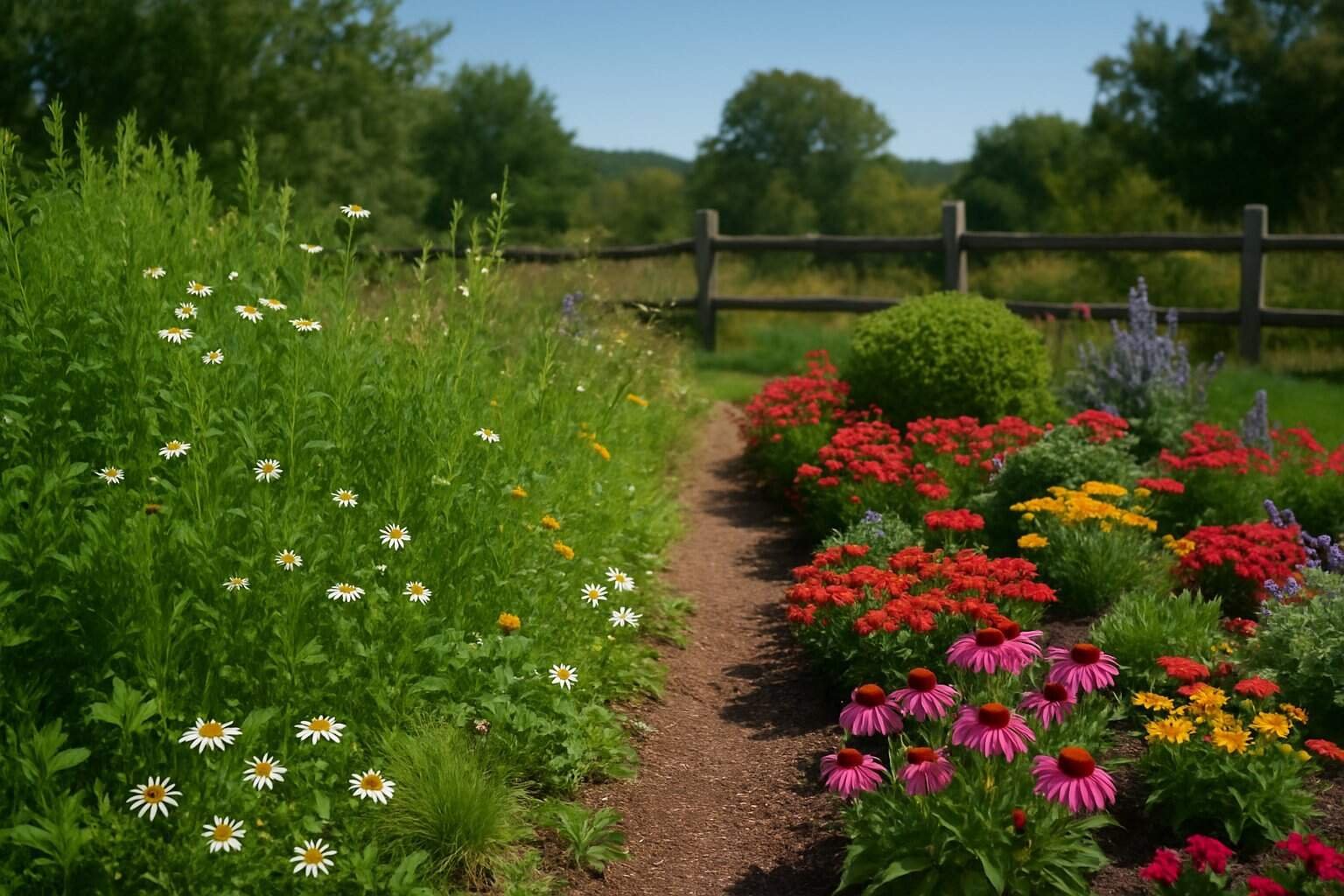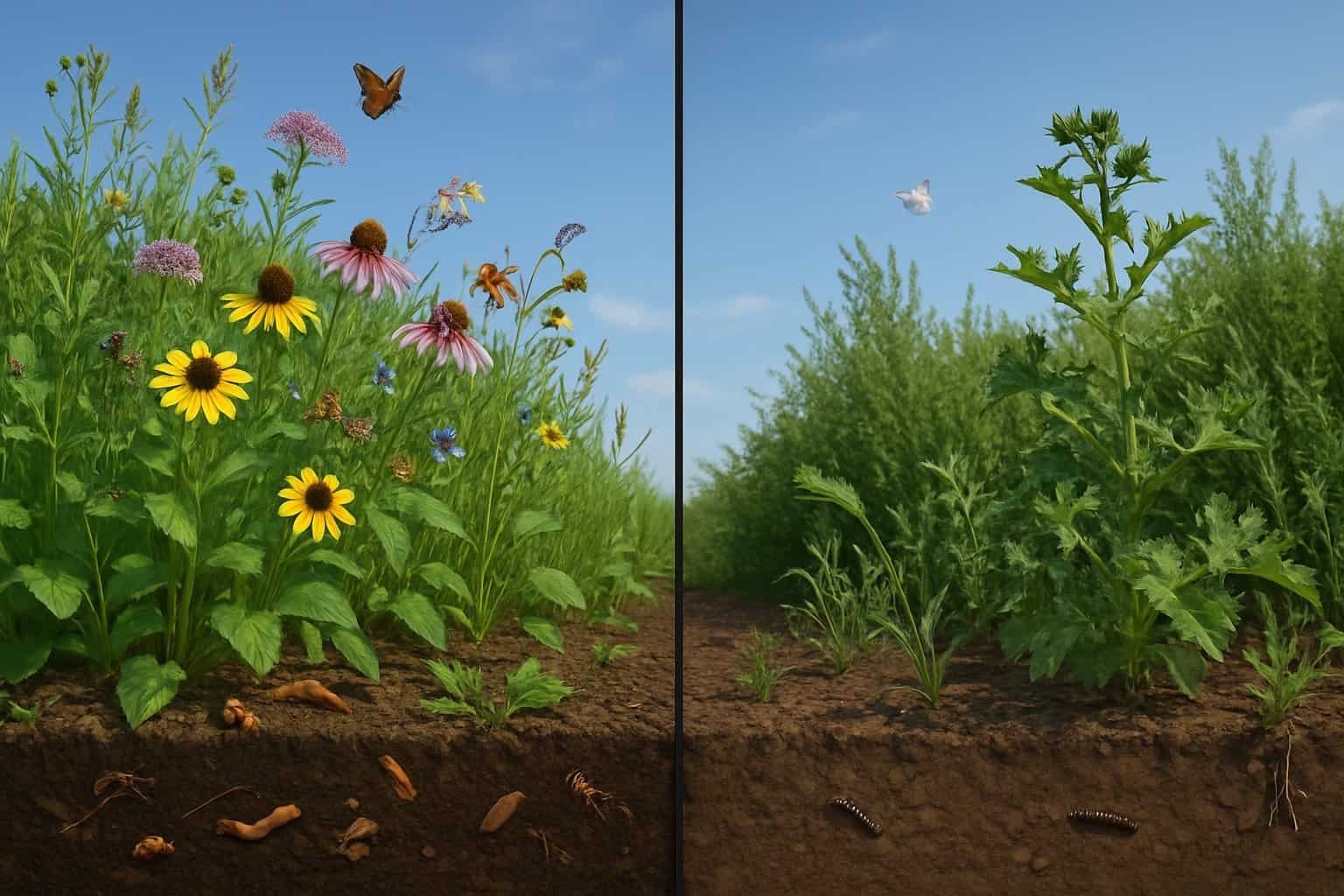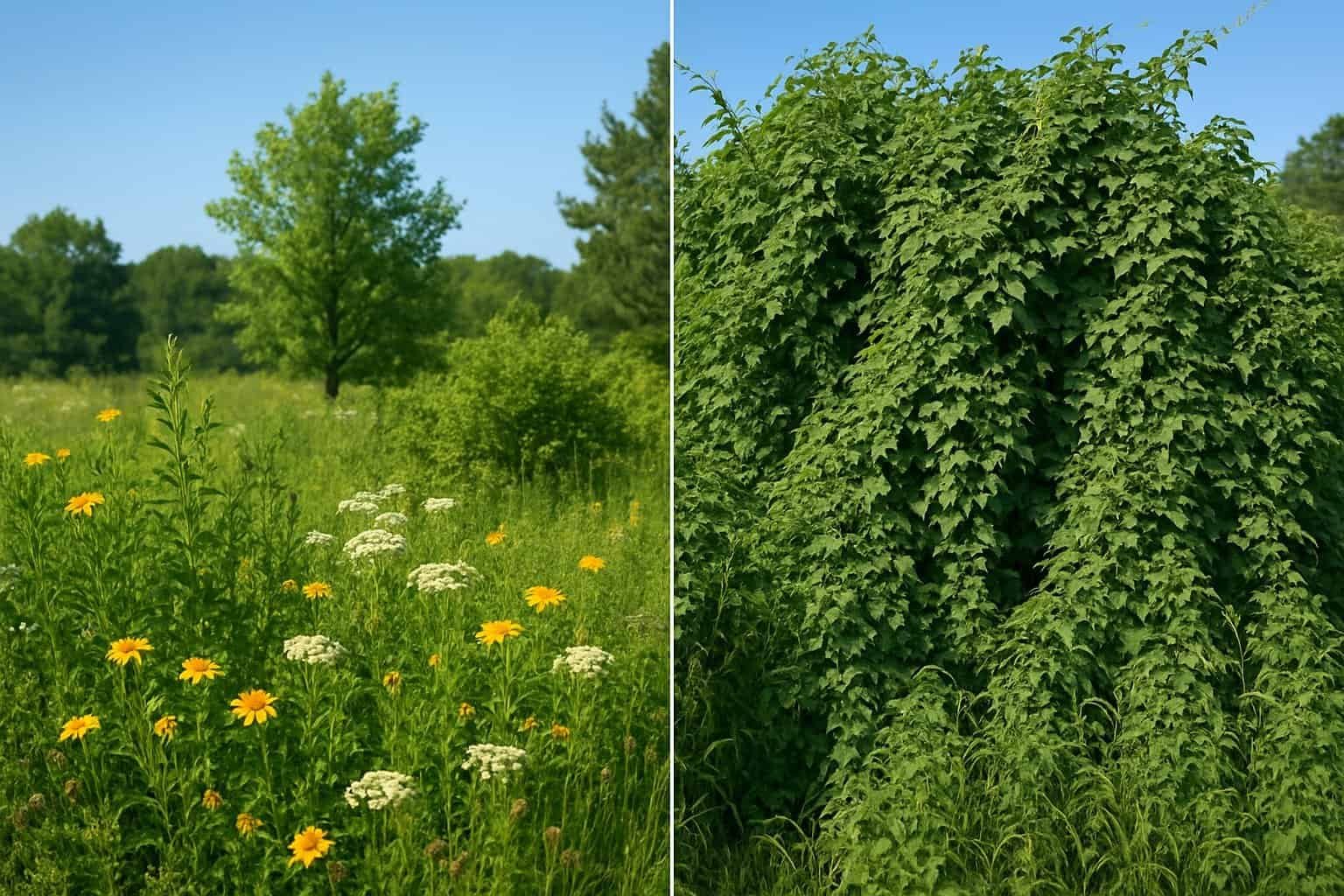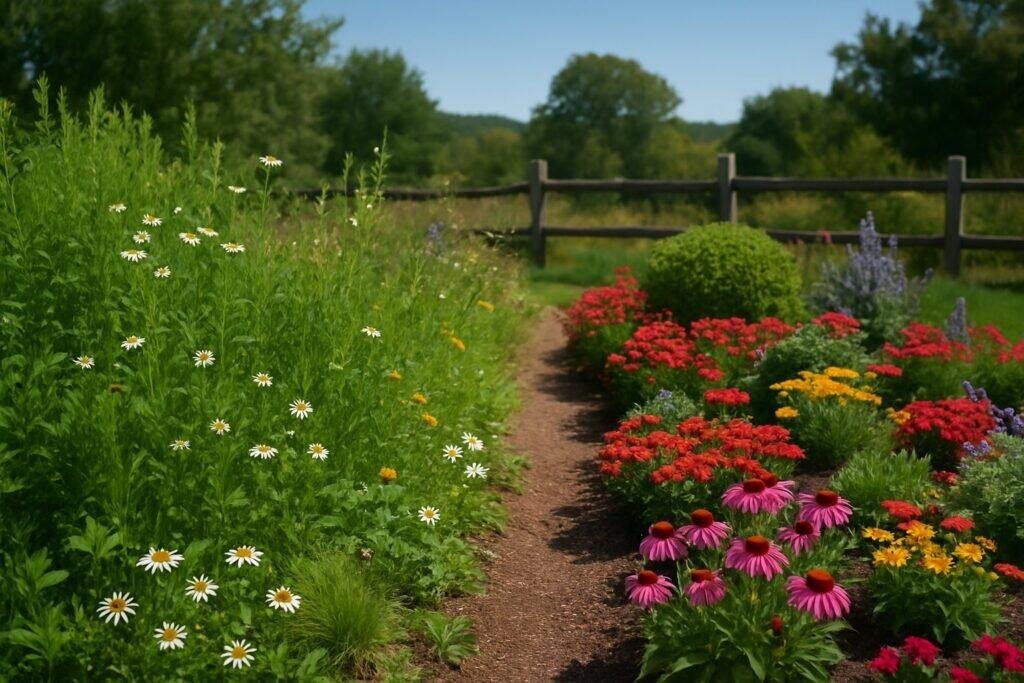Plants surround us, but not all of them belong in our local ecosystems. Native plants have evolved in specific regions over thousands of years.
They develop relationships with local wildlife, insects, and soil conditions. Choosing native plants for your garden supports local ecosystems and requires less maintenance.
These plants help preserve biodiversity in your area.

Non-native plants, though sometimes beautiful and useful, come from different regions. They can disrupt local ecological balances.
Some become invasive, crowding out native species and reducing habitat for local wildlife. This concern has sparked interest in sustainable landscaping practices that prioritize regional plant species.
Key Takeaways
- Native plants support local wildlife, need less water and maintenance, and help preserve regional biodiversity.
- Non-native plants can disrupt ecosystems, with some becoming invasive and threatening local plant communities.
- Incorporating native plants into gardens and landscapes creates sustainable spaces that connect people with their natural heritage.
Defining Native and Non-Native Plants
We can categorize plants based on their historical presence in a region. This distinction helps us understand ecosystem dynamics and make informed landscaping choices.
What Are Native Plants?
Native plants are species that have evolved in a specific region over thousands of years. They occur naturally in an ecosystem without human introduction.
These plants develop alongside local wildlife, soil conditions, and climate patterns. Native plants establish complex relationships with native insects, birds, and other wildlife.
For example, monarch butterflies rely on native milkweed for reproduction. Native plants typically need less maintenance once established.
They adapt to local rainfall and soil, often requiring less water and fertilizer than non-natives. Native plant species contribute to biodiversity and ecosystem stability.
They provide food and habitat for local wildlife and help maintain the natural balance of the region.
Understanding Non-Native Plants
Non-native plants, also called exotic or alien species, are introduced to regions outside their natural range. Human activities like agriculture, gardening, and global trade move these plants across geographical boundaries.
Many common garden plants and crops are non-native. Tulips in North America, originally from Turkey, and tomatoes in Europe, originally from South America, are everyday examples.
Non-native plants aren’t always harmful. Many coexist with native species without causing problems.
These “well-behaved” non-natives can add diversity to gardens and landscapes. However, some non-natives become invasive when they escape cultivation.
Without natural predators or competitors, they spread aggressively and disrupt ecosystems. Japanese knotweed and purple loosestrife are notorious examples that have caused significant ecological damage.
The Difference Between Native and Non-Native Species
The key difference lies in evolutionary history and ecological relationships. Native plants evolved within their ecosystems over thousands of years, while non-natives were introduced by human activity.
Ecological Impact:
- Native plants: Support local food webs and wildlife
- Non-native plants: May not provide proper nutrition for native wildlife
- Invasive non-natives: Can displace native species and reduce biodiversity
Adaptation to Local Conditions:
| Characteristic | Native Plants | Non-Native Plants |
|---|---|---|
| Water needs | Adapted to local rainfall | May require irrigation |
| Pest resistance | Evolved defenses | May need pesticides |
| Maintenance | Generally lower | Often higher |
Non-natives sometimes need more resources to thrive, including water, fertilizer, and pest control. This increases maintenance needs and can have environmental impacts.
Ecological Importance of Native Plants

Native plants form the backbone of healthy ecosystems. They provide essential services that non-native species cannot replicate.
These plants have evolved alongside local wildlife for thousands of years. This creates interdependent relationships that sustain our natural areas.
Role in Supporting Local Biodiversity
Native plants contribute to biodiversity in any ecosystem. They’ve adapted to local soil, rainfall, and climate over thousands of years.
This specialization allows them to thrive without excessive water or fertilizers. Native plant communities create diverse habitats with multiple layers, from ground covers to shrubs to canopy trees.
Each layer supports different wildlife species and ecological functions. Research shows that areas with native plants support 3-5 times more bird and insect species than areas dominated by non-native plants.
This diversity creates resilient ecosystems that can better withstand environmental stresses like drought or disease. Native plant roots also help prevent erosion and improve soil health by adding organic matter.
Their deep root systems store carbon and create channels for water to penetrate.
Wildlife Interactions and Habitat Value
Native wildlife depends on native plants for survival. Many animals have co-evolved with specific plant species, creating relationships that non-native plants cannot fulfill.
Birds rely on native plants for nesting materials, shelter, and food sources. Native berries, nuts, and seeds provide essential nutrition at critical times.
For example, oak trees support over 500 caterpillar species, which become vital food for nesting birds.
Native Plant-Wildlife Connections:
- Cardinal flower → Hummingbirds
- Milkweed → Monarch butterflies
- Acorns → Squirrels, deer, birds
- Native grasses → Small mammals, ground-nesting birds
Mammals, reptiles, and amphibians also depend on native plant communities. They provide cover from predators, temperature regulation, and breeding grounds.
Even dead native plants support wildlife by creating shelter and returning nutrients to the soil.
Pollinators and the Food Web
Pollinators like bees, butterflies, and moths have evolved alongside native flowering plants. These connections form the foundation of our food webs.
Native pollinators often have timing and physical adaptations that match native plant flowering cycles. When non-native plants dominate, these critical relationships break down.
Many native bees have tongue lengths matched to the flower structures of specific native plants. The timing of native plant flowering is also crucial.
They provide continuous blooms throughout the growing season, ensuring pollinators have consistent food sources. This “pollination calendar” supports diverse pollinator populations year-round.
These pollinator relationships extend beyond insects. Hummingbirds, bats, and some mammals serve as pollinators for native plants.
The entire food web depends on these interactions, as pollinators become food for birds, spiders, and other wildlife.
Impacts of Non-Native and Invasive Species

When non-native plants enter new environments, they can create significant changes. Some introduce minor variations to local ecosystems, while others become invasive and cause substantial harm.
Ecological Disruption
Non-native species often compete with native plants for essential resources like water, sunlight, and soil nutrients. This competition can weaken native plant populations over time.
Many invasive plants grow rapidly and spread aggressively. Purple loosestrife, for example, can produce over 2 million seeds annually and quickly dominate wetland areas.
The displacement of native plants disrupts food webs that wildlife depend on. Native insects often cannot use non-native plants for food or habitat, causing insect population declines.
This ripple effect impacts birds and other animals that feed on these insects. Research shows areas dominated by non-native plants support 29% fewer insects and 27% fewer birds than native plant communities.
Invasive Plants and Their Consequences
Invasive plants can dramatically alter entire habitats. Kudzu, nicknamed “the vine that ate the South,” can grow up to a foot per day and completely cover trees, buildings, and landscapes.
Some invasive species change soil chemistry. Garlic mustard releases chemicals that inhibit the growth of competing plants and disrupt beneficial fungi relationships in the soil.
Economic costs of invasive species are substantial. The U.S. spends about $40 billion each year managing invasive species and repairing their damage.
Water-hungry invasive plants like tamarisk can drain water tables and dry up streams in arid regions. One mature tamarisk can consume up to 200 gallons of water per day.
Fire regimes often change when invasive grasses like cheatgrass replace native vegetation. This creates more frequent and intense wildfires.
Benefits of Growing Native Plants
Native plants offer remarkable advantages for gardens and landscapes. They have evolved over thousands of years to thrive in local conditions without extra help from humans.
Water Conservation and Soil Health
Native plants typically need less water than non-native species once established. Their deep root systems adapt to local rainfall, allowing them to survive with minimal supplemental watering.
Many native species can thrive through seasonal dry periods without irrigation. Native plant roots also improve soil structure and prevent erosion.
Their extensive root networks create channels for water absorption, reducing runoff during heavy rains. This helps replenish groundwater supplies naturally.
These plants don’t usually need fertilizers or soil amendments. They flourish in local soil conditions, whether sandy, clay-based, or acidic.
This adaptation reduces the need for chemical additives that can harm waterways through runoff.
Supporting Native Wildlife and Pollinators
Native plants provide essential habitat for local wildlife. Birds, mammals, and insects rely on native vegetation for food and shelter throughout their life cycles.
Pollinators like bees, butterflies, and hummingbirds have co-evolved with native plants. Native flowers offer nectar and pollen at times when these creatures need them most.
Research shows native plants support up to four times more species of caterpillars than non-natives. Native seeds, nuts, and berries provide crucial nutrition for birds and small mammals.
The timing of these food sources aligns with local wildlife needs, especially during migration and breeding seasons. Creating gardens with diverse native plants helps rebuild functioning ecosystems.
Even small native gardens serve as stepping stones for wildlife moving through fragmented habitats.
Native Plants in Landscaping and Gardening
Native plants transform gardens into vibrant, sustainable spaces that support local ecosystems. These plants have evolved in your region for thousands of years.
They adapt well to local conditions and benefit wildlife.
Native Gardens and Home Garden Use
Creating a native garden in your home landscape offers many benefits. Native plants typically require less water, fertilizer, and maintenance than non-native species.
They’ve adapted to local rainfall and soil conditions over centuries. Native gardens attract local wildlife, especially pollinators like butterflies and bees.
These visitors help your garden thrive and support the broader ecosystem. Many homeowners worry that native plants look messy or wild.
Today’s native gardens can be structured and beautiful. Designers now create formal native landscapes with clean edges and organized planting schemes.
Native gardens also connect people to their regional identity. Using plants that naturally grow in your area creates a sense of place that imported species cannot match.
Popular Native Landscape Plants
Several native plants stand out for their beauty and adaptability in home landscapes. Purple coneflower and black-eyed Susans add bright colors to any garden while attracting butterflies and providing seeds for birds.
Native wildflowers create seasonal displays that change throughout the year. They often self-seed, expanding their presence naturally over time.
Native oak trees serve as keystone species, supporting hundreds of insect species that feed birds and other wildlife. Even a single oak can dramatically increase biodiversity in your yard.
For shady areas, native ferns and woodland plants thrive where many non-natives struggle. They create lush, low-maintenance ground covers that prevent erosion.
Regional native plant societies offer lists of recommended species for specific areas. These resources help homeowners select plants that will thrive in their particular growing conditions.
Non-Native Plants in Horticulture
Non-native plants play a significant role in modern horticulture. They offer both benefits and challenges to gardeners and ecosystems.
Their use requires careful attention to local conditions. Gardeners must consider potential ecological impacts.
Advantages and Challenges
Non-native plants often have qualities that make them appealing for gardens and landscapes. Many are bred for enhanced visual appeal or improved disease resistance.
Some non-native plants thrive in urban environments where native species might struggle. Certain cultivars require less water or maintenance, which makes them practical for busy homeowners.
However, non-native species can escape cultivation and become invasive. They may outcompete native plants and disrupt ecosystems.
This can reduce biodiversity and alter habitats for wildlife. Some non-natives may not provide enough food or shelter for local insects and birds.
They might also need more water, fertilizers, or pest control than plants adapted to local conditions.
Choosing Appropriate Non-Native Species
Selecting suitable non-native plants requires research. Gardeners should avoid species with known invasive tendencies in their region.
Important selection criteria:
- Adaptation to local soil conditions
- Water requirements that match local rainfall
- Non-aggressive growth habits
- Resistance to becoming invasive
“Nativars”—cultivated varieties of native plants—can offer a compromise. They provide some benefits of non-natives while maintaining ecological connections.
Consider the plant’s function in the landscape. Is it purely ornamental, or will it offer shade, erosion control, or wildlife habitat?
The answer helps determine if a non-native option is appropriate. Many botanical gardens keep lists of non-native plants that perform well locally without threatening native ecosystems.
These resources can help gardeners make responsible choices.
Conservation Efforts and Education
Many groups work to protect native plants through community programs. Educational resources help people understand why native plants matter.
The Role of Organizations like Audubon
Audubon Society leads efforts to protect native plants nationwide. They run the Plants for Birds program, which connects homeowners with information about local native plants.
Audubon’s native plant database helps people find plants suited to their region. This tool makes it easier for gardeners to create habitats for local birds and insects.
Many Audubon chapters organize native plant sales and garden tours. These events give people hands-on experience with native species.
The organization also works with nurseries to increase the availability of native plants. This partnership helps make native plants more accessible.
Promoting Awareness and Responsible Plant Choices
Education campaigns show the benefits of native plants for biodiversity. Public workshops teach people how to identify invasive species and replace them with native alternatives.
Community demonstration gardens display native plants in real settings. These living classrooms help visitors see how beautiful native landscapes can be.
Many cities now offer rebates for replacing lawns with native plants. These programs show how native gardens conserve water and reduce maintenance.
Social media campaigns share success stories of habitat restoration. Before-and-after photos show how quickly native plants can attract wildlife.
Local gardening groups organize plant swaps and seed exchanges. These events build community and help native plants reach more gardens.
Frequently Asked Questions
People often have questions about native and non-native plants. These questions help clarify important distinctions and common misunderstandings.
What differentiates a native plant from an invasive plant?
Native plants naturally occur in a region without human introduction. They evolved over thousands of years alongside local wildlife and conditions.
Invasive plants are usually non-native species that spread aggressively and harm ecosystems. They outcompete native species and often lack natural predators.
Not all non-native plants become invasive. Invasiveness means a plant spreads uncontrollably and disrupts natural ecosystems.
Are there non-native species that do not harm ecosystems?
Many non-native plants coexist peacefully with native species. These “naturalized” plants have integrated into ecosystems without causing major disruption.
Common garden plants like daylilies and hostas are non-native to North America but usually stay within cultivated areas. They provide beauty and sometimes resources for wildlife without threatening native communities.
Most agricultural crops grown worldwide are non-native to their regions but remain contained within managed systems.
How can non-native plants affect local ecosystems?
Non-native plants can reduce biodiversity by outcompeting native species for sunlight, water, nutrients, and space. This displaces plants that local wildlife depends on.
Some non-natives alter soil chemistry or change the environment. For example, purple loosestrife can change wetland hydrology.
Non-native plants often disrupt food webs by not providing the right nutrition for native insects. This affects birds and other animals higher in the food chain.
What criteria classify a plant as native to a region?
A plant is native if it occurred in an area before European settlement. This usually means the plant evolved in a location without human introduction.
Geographic boundaries like mountains, rivers, or deserts naturally limit plant distribution. Plants that cross these boundaries without human help may still be considered native.
Climate adaptation is also important—native plants are suited to the rainfall, temperature patterns, and seasonal changes of their regions.
What are some common misconceptions about non-native plants?
Some people think all non-native plants are harmful. Many introduced plants cause no ecological harm and offer benefits like food or ornamental value.
Others believe native plants always look “wild” or messy. In reality, many native plants fit well into formal garden designs and can be maintained neatly.
Another misconception is that native plants require no care. While they’re well-adapted to local conditions, they still need proper care, especially when first established.
What are the primary differences between native and indigenous plants?
The terms “native” and “indigenous” are often used interchangeably when referring to plants. Both describe species that naturally occur in a region without human introduction.
Indigenous sometimes carries cultural connotations. It can refer to plants that have historical importance to indigenous peoples of a region.
These plants may have traditional uses for food, medicine, or ceremonies. Scientific classification typically uses “native” in ecological contexts.
“Indigenous” might appear more frequently in anthropological or cultural discussions about plant use and significance.


